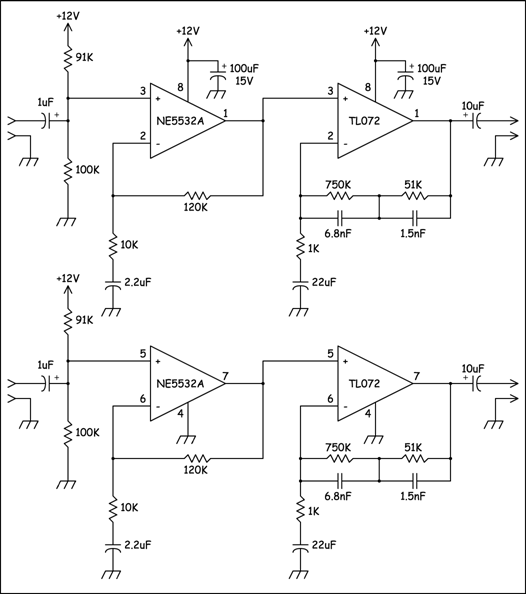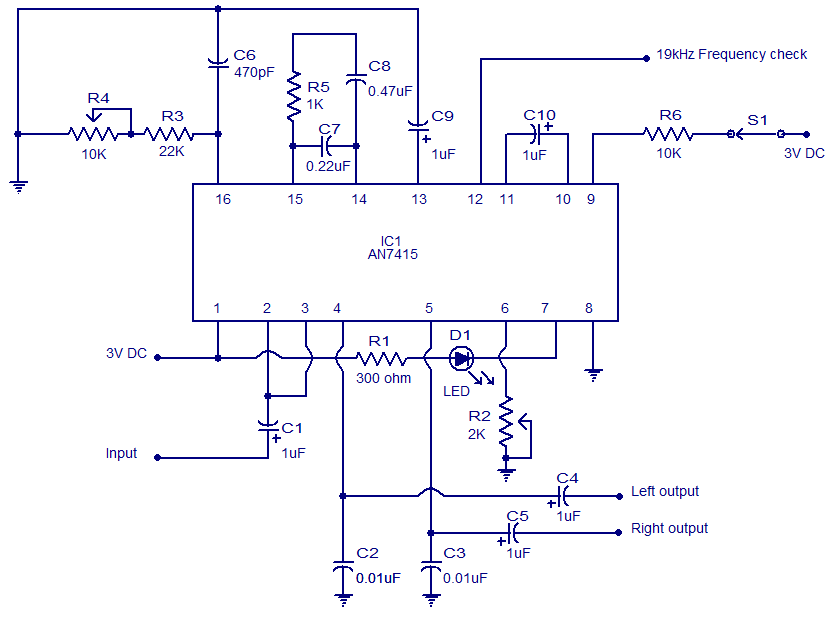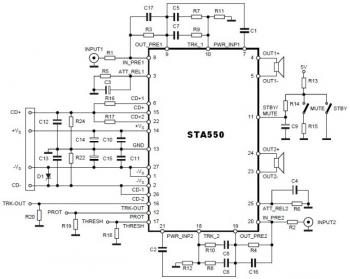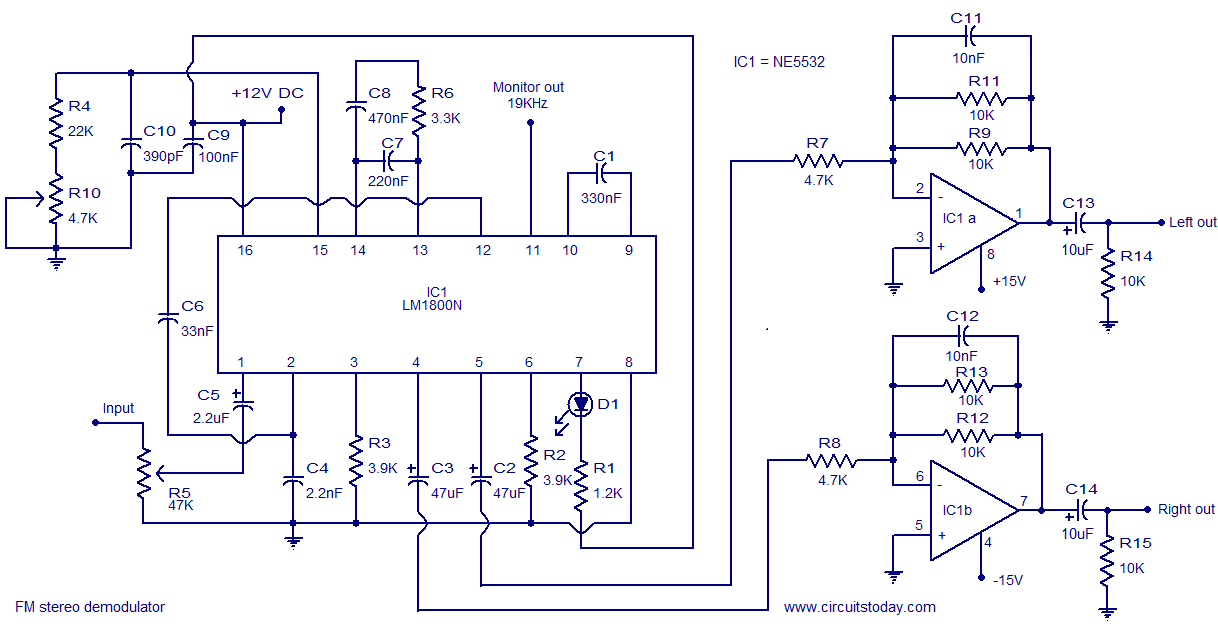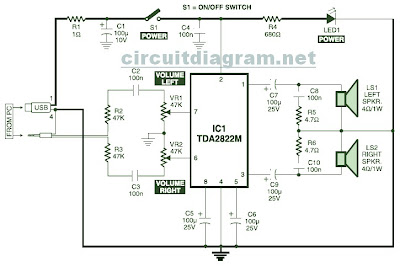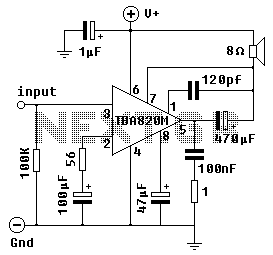
Stereo balancer
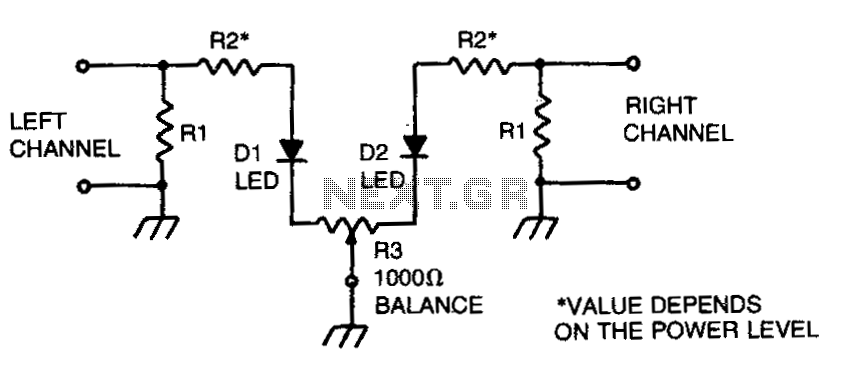
This circuit enables the adjustment of the gain for two stereo channels to achieve equal levels. The signal across the load resistors for both channels is sampled using resistors R2, with their values depending on the power level. For a typical 20 milliampere LED, a resistor value of approximately 2 kΩ per watt is recommended. For a 10-watt system, a resistor value of 25,000 ohms should be utilized. To set up the circuit, short the two inputs and connect them to one channel of a power amplifier. After applying a signal, adjust R3 until both LEDs illuminate with the same brightness. The balancer is then ready for operation. Connect the inputs of the stereo balancer to the output of the power amplifier, and adjust either the independent volume controls or the balance control until both LEDs shine at an equal level. For in-line use with loudspeakers, both Rls should be disconnected, and the speakers should be used as the load.
This circuit functions as a stereo balancer, allowing for precise gain matching between two audio channels. It employs a feedback mechanism using resistors R2 to sample the output signal across the load resistors of each channel. The choice of resistor values is crucial; for example, using 2 kΩ resistors for 20 mA LEDs ensures that the circuit operates within safe limits while providing adequate brightness. The adjustment of R3 serves as a fine-tuning mechanism, allowing the user to match the brightness of the two LEDs, which visually indicates the balance between the channels.
In practical applications, the circuit can be integrated into various audio systems, enhancing the listening experience by ensuring that both channels deliver sound at the same level. The setup process is straightforward, requiring only the connection of inputs to the power amplifier and subsequent adjustments to achieve the desired output. When utilized with loudspeakers, the circuit's flexibility allows for easy adaptation by removing the load resistors and directly connecting the speakers, maintaining functionality without compromising audio quality.
Overall, this stereo balancer circuit is an effective solution for achieving equal gain levels in audio applications, making it suitable for both amateur and professional audio setups.This circuit will allow you to set the gain of two stereo channels to the same level. The signal across the two channel-load resistors is sampled by resistors R2. (Values of these resistors will depend upon the power level) For most 20 milliampere LED, use approximately 2 K per watt. (For a 10-watt system use a 25,000 ohm resistor) To set up, short the two inputs and connect them to one channel of a power amplifier.
Apply a signal and adjust R3 until both LEDs glow at the same brightness level The balancer is ready for use. Connect the inputs of the stereo balancer across the output of the power amplifier, and then turn up either the independent volume controls, or the balance control until both LEDs glow at the same level. To use this circuit in-line with loudspeakers, disconnect both Rls, and use the speakers as the load.
🔗 External reference
This circuit functions as a stereo balancer, allowing for precise gain matching between two audio channels. It employs a feedback mechanism using resistors R2 to sample the output signal across the load resistors of each channel. The choice of resistor values is crucial; for example, using 2 kΩ resistors for 20 mA LEDs ensures that the circuit operates within safe limits while providing adequate brightness. The adjustment of R3 serves as a fine-tuning mechanism, allowing the user to match the brightness of the two LEDs, which visually indicates the balance between the channels.
In practical applications, the circuit can be integrated into various audio systems, enhancing the listening experience by ensuring that both channels deliver sound at the same level. The setup process is straightforward, requiring only the connection of inputs to the power amplifier and subsequent adjustments to achieve the desired output. When utilized with loudspeakers, the circuit's flexibility allows for easy adaptation by removing the load resistors and directly connecting the speakers, maintaining functionality without compromising audio quality.
Overall, this stereo balancer circuit is an effective solution for achieving equal gain levels in audio applications, making it suitable for both amateur and professional audio setups.This circuit will allow you to set the gain of two stereo channels to the same level. The signal across the two channel-load resistors is sampled by resistors R2. (Values of these resistors will depend upon the power level) For most 20 milliampere LED, use approximately 2 K per watt. (For a 10-watt system use a 25,000 ohm resistor) To set up, short the two inputs and connect them to one channel of a power amplifier.
Apply a signal and adjust R3 until both LEDs glow at the same brightness level The balancer is ready for use. Connect the inputs of the stereo balancer across the output of the power amplifier, and then turn up either the independent volume controls, or the balance control until both LEDs glow at the same level. To use this circuit in-line with loudspeakers, disconnect both Rls, and use the speakers as the load.
🔗 External reference
